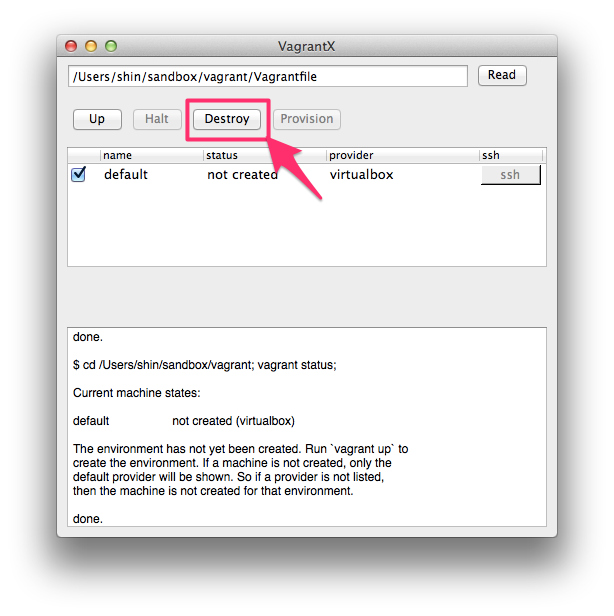
- #VAGRANT DESTROY HOW TO#
- #VAGRANT DESTROY INSTALL#
- #VAGRANT DESTROY MANUAL#
- #VAGRANT DESTROY DOWNLOAD#
Using the vagrant-service-manager Plugin"Ĥ.1.1. Using the vagrant-service-manager Plugin"Ĭollapse section "4.1. Using the vagrant-service-manager PluginĮxpand section "4.1. Using Vagrant Container Development Kit Plugins"Ĥ.1. Using Vagrant Container Development Kit Plugins"Ĭollapse section "4. Using Vagrant Container Development Kit PluginsĮxpand section "4.

Installing Red Hat Container Development Kitģ. Understanding Container Development Kit Documentationġ.4.1. Introducing Red Hat Container Development Kit"ġ.1. Introducing Red Hat Container Development Kit"Ĭollapse section "1. Introducing Red Hat Container Development KitĮxpand section "1.

This might take a while, depending on your internet speed.Īfter some time (while the script is still running) you will notice that a window with an Ubuntu Virtual Machine pops-up.ĭon't log in yet, wait until the script in the Console is finished.
#VAGRANT DESTROY DOWNLOAD#
Vagrant will now automatically download an Ubuntu image (+- 2.6 Gb), create a virtualbox image from it and run the installation puppet script when finished. Note: In case of an error complaining about not being able to resolve a URL (for instance to ) then try using a different internet connection not behind a proxy.

Make sure that the file is named like this: Vagrantfile without an extension!.Also disable Hyper-V in Windows (can be found in Windows Features)įirst create a new directory (for example: D:\My Vagrant Images\OSGP Development\)īrowse to OSGP/Config/tree/development/vagrant and save the png image and Vagrantfile files in your newly created directory.Remember to enable Virtualization in your system BIOS.
#VAGRANT DESTROY INSTALL#
Note: If you did a fresh install of Vagrant and already had a command prompt open, make sure you close this command prompt and open it again. Note: If you already have Vagrant, make sure it is at least version 2.1.1Ĭomplete the installation and restart your PC. Vagrant is available at the following URL: (Open Oracle VM VirtualBox Manager -> Preferences -> General -> Default Machine Folder). Note: Check whether Virtualbox stores the images on a drive with enough free space. Note: If you already have VirtualBox, make sure it is at least version 5.1.32 Start by downloading VirtualBox by going to The installation procedure has been tested on Windows 7, Windows 10, MacOS, Ubuntu 14.04 and Ubuntu 16.04. At least 20 GB free space, 50 GB free space recommended.At least 6 GB RAM, 8 GB RAM recommended.Core i5/i7 ~2.5GHz Dual Core, Quad Core recommended.The following system requirements are recommended:
#VAGRANT DESTROY HOW TO#
The following steps will describe how to install VirtualBox, Vagrant and kick off the procedure by running the vagrant up command. To improve the usability of the Installation process, a Vagrant file and some puppet scripts are used to automatically set-up an virtual Open Smart Grid Platform development environment.

Overview Creating a Virtual Machine using Virtual Box and Vagrant
#VAGRANT DESTROY MANUAL#
If you would like to follow the manual installation procedure, please proceed to the Manual Installation Chapter. This document describes the automatic installation procedure for your Open Smart Grid Platform development environment. GetGetMbusEncryptionKeyStatusB圜hannelResponse GetSetEncryptionKeyExchangeOnGMeterResponse


 0 kommentar(er)
0 kommentar(er)
